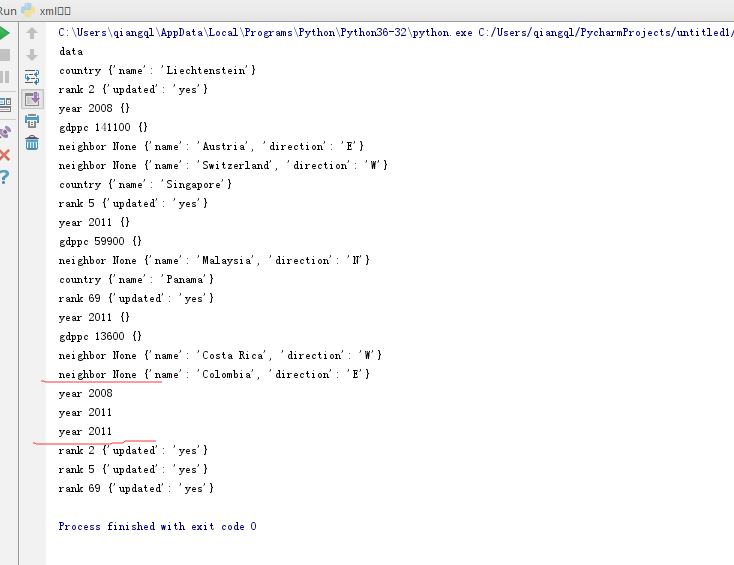这些我都大体看了看,准备以后用的时候过来找
xml是实现不同语言或程序之间进行数据交换的协议,跟json差不多,但json使用起来更简单,不过,古时候,在json还没诞生的黑暗年代,大家只能选择用xml呀,至今很多传统公司如金融行业的很多系统的接口还主要是xml。
xml的格式如下,就是通过<>节点来区别数据结构的:
1 <?xml version="1.0"?> 2 <data> 3 <country name="Liechtenstein"> 4 <rank updated="yes">2</rank> 5 <year>2008</year> 6 <gdppc>141100</gdppc> 7 <neighbor name="Austria" direction="E"/> 8 <neighbor name="Switzerland" direction="W"/> 9 </country> 10 <country name="Singapore"> 11 <rank updated="yes">5</rank> 12 <year>2011</year> 13 <gdppc>59900</gdppc> 14 <neighbor name="Malaysia" direction="N"/> 15 </country> 16 <country name="Panama"> 17 <rank updated="yes">69</rank> 18 <year>2011</year> 19 <gdppc>13600</gdppc> 20 <neighbor name="Costa Rica" direction="W"/> 21 <neighbor name="Colombia" direction="E"/> 22 </country> 23 </data>
xml协议在各个语言里的都 是支持的,在python中可以用以下模块操作xml
1 # coding=utf-8 2 import xml.etree.ElementTree as ET 3 4 tree = ET.parse('xml.xml') 5 root = tree.getroot() 6 print(root.tag) #获得标标签 7 8 #遍历xml文档 9 for child in root: 10 print(child.tag,child.attrib) #获得标签,还有里边的属性 11 for i in child: 12 print(i.tag,i.text,i.attrib) #获得标签,属性,已经标签所对应的内容 13 14 #只遍历year 节点 15 for node in root.iter('year'): 16 print(node.tag,node.text)

修改和删除xml文档内容
1 import xml.etree.ElementTree as ET 2 3 tree = ET.parse("xmltest.xml") 4 root = tree.getroot() 5 6 #修改 7 for node in root.iter('year'): 8 new_year = int(node.text) + 1 9 node.text = str(new_year) 10 node.set("updated","yes") 11 12 tree.write("xmltest.xml") 13 14 15 #删除node 16 for country in root.findall('country'): 17 rank = int(country.find('rank').text) 18 if rank > 50: 19 root.remove(country) 20 21 tree.write('output.xml')
自己创建xml文档
1 import xml.etree.ElementTree as ET 2 3 4 new_xml = ET.Element("namelist") 5 name = ET.SubElement(new_xml,"name",attrib={"enrolled":"yes"}) 6 age = ET.SubElement(name,"age",attrib={"checked":"no"}) 7 sex = ET.SubElement(name,"sex") 8 sex.text = '33' 9 name2 = ET.SubElement(new_xml,"name",attrib={"enrolled":"no"}) 10 age = ET.SubElement(name2,"age") 11 age.text = '19' 12 13 et = ET.ElementTree(new_xml) #生成文档对象 14 et.write("test.xml", encoding="utf-8",xml_declaration=True) 15 16 ET.dump(new_xml) #打印生成的格式